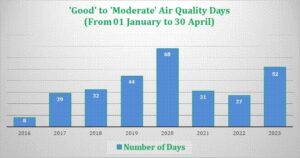
Delhi remained the most polluted city in the year ending September 30 — although its air quality improved marginally — with a PM2.5 concentration of 100.1 micrograms per cubic meter, which is three times the government’s safe limit, says a study.
The analysis, conducted by the independent think tank Climate Trends and tech firm Respirer Living Sciences, manufacturers of real-time IoT-based air quality monitoring devices, indicated that Aizawl in Mizoram boasts the cleanest air in the country, with a PM2.5 level of only 11.1 micrograms per cubic meter.
Four more cities from the National Capital Region — Faridabad (89 micrograms per cubic meter), Noida (79.1 micrograms per cubic meter), Ghaziabad (78.3 micrograms per cubic meter) and Meerut (76.9 micrograms per cubic meter) — also feature among the top 10 most polluted cities. The report is based on the analysis of the government’s PM2.5 data from October 1, 2022, to September 30, 2023, and focuses on the cities covered by the National Clean Air Programme, which aims to achieve a 40 percent reduction in particulate matter concentration by 2026.
Patna, ranking as the second most polluted city with an average PM2.5 concentration of 99.7 micrograms per cubic meter, saw a 24 percent deterioration in air quality compared to the preceding year. The seven most polluted cities, including Delhi, Patna, Muzaffarpur, Faridabad, Noida, Ghaziabad, and Meerut, are all located in the Indo-Gangetic Plains, as highlighted in the report.
However, the analysts noted that PM2.5 concentration in Delhi, Faridabad, Noida, Ghaziabad and Meerut reduced by 4 percent, 12 percent, 12 percent, 25 percent and 11 percent, respectively, during the study period. “The analysis reflects that there has been improvement in the Indo-Gangetic Plain cities over the last few years. However, considering the enormous pollution load, these cities continue to experience the highest PM levels in the country,” said Aarti Khosla, the director of Climate Trends, as per a media report.
“While measures like the Pradhan Mantri Ujjwala Yojana or hyperlocal developments like the peripheral highways around Delhi are positive actions, there is a need for a scientific approach to address air quality issues in a sustained manner through an airshed approach,” she added.
In an effort to combat the persisting problem of air pollution, the Kejriwal government has launched the ‘Green War Room’ in Delhi, resulting in a notable improvement in the city’s Air Quality Index (AQI), which now stands at 133, well below the threshold of 201. The war room, equipped with enhanced monitoring capabilities, has increased its teams from nine to 17, with Nandita Malhotra spearheading the initiative.
According to the AQI scale, the air quality check between 0 and 50 are considered “good”, 51 and 100 are “satisfactory”, 101 and 200 are “moderate”, 201 and 300 are “poor”, 301 and 400 are “very poor”, and 401 and 450 are “severe” and “severe+” when AQI exceeds 450.
“Our first plan is to control pollution in Delhi. The second thing that is part of our winter action plan is coordinating with the states where stubble burning happens. Punjab has also prepared this time. According to reports, there will be less stubble burning in Punjab,” Delhi Environment Minister Gopal Rai said.
In addition, the government has also started deploying 530 water sprinklers to prevent dust pollution at 13 hotspots, and 385 teams will check vehicles’ pollution certificates and prevent the plying of overage cars.
While concerted efforts are being made at various levels to tackle air pollution, the battle for cleaner air in Delhi continues as the winter season approaches. The Graded Response Action Plan (GRAP) is set to come into force from October 1, offering a structured approach to address air quality concerns. The plan encompasses four stages based on the Air Quality Index (AQI) readings, ranging from ‘poor’ to ‘severe plus’. The Commission for Air Quality Management, entrusted with improving air quality in Delhi and its surrounding areas, has adjusted the GRAP framework to adapt to evolving circumstances.
There are a total of four stages of GRAP. Stage 1 – ‘poor’ (AQI 201-300); Stage 2 – ‘very poor’ (AQI 301-400); Stage 3 – ‘severe’ (AQI 401-450); and Stage 4 – ‘severe plus’ (AQI >450).




